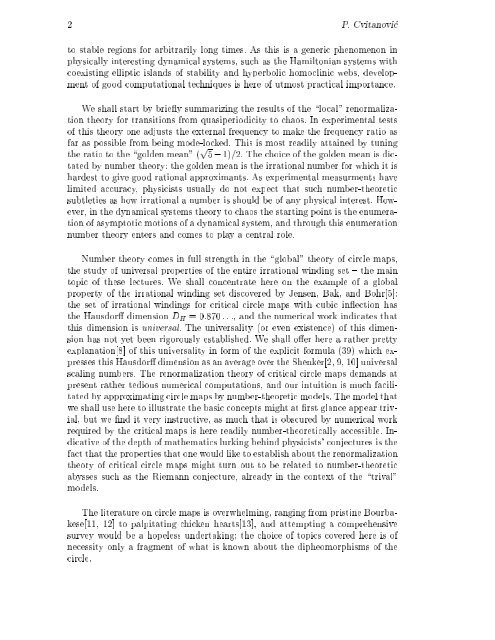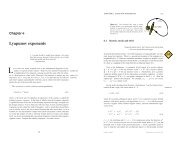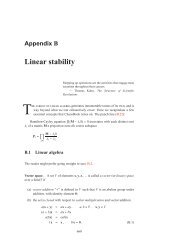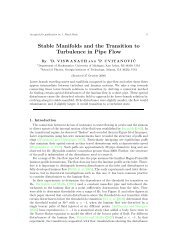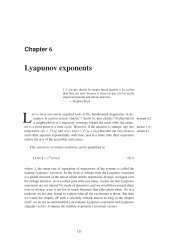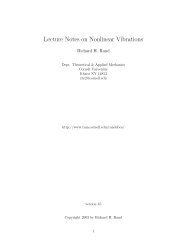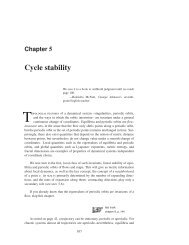10 Circle Maps: Irrationally Winding - Center for Nonlinear Science
10 Circle Maps: Irrationally Winding - Center for Nonlinear Science
10 Circle Maps: Irrationally Winding - Center for Nonlinear Science
Create successful ePaper yourself
Turn your PDF publications into a flip-book with our unique Google optimized e-Paper software.
2 P. Cvitanovic<br />
to stable regions <strong>for</strong> arbitrarily long times. As this is a generic phenomenon in<br />
physically interesting dynamical systems, such as the Hamiltonian systems with<br />
coexisting elliptic islands of stability and hyperbolic homoclinic webs, development<br />
of good computational techniques is here of utmost practical importance.<br />
We shall start by briey summarizing the results of the \local" renormalization<br />
theory <strong>for</strong> transitions from quasiperiodicity tochaos. In experimental tests<br />
of this theory one adjusts the external frequency to make the frequency ratio as<br />
far as possible from being mode-locked. This is most readily attained by tuning<br />
the ratio to the \golden mean" ( p 5 ; 1)=2. The choice of the golden mean is dictated<br />
by number theory: the golden mean is the irrational number <strong>for</strong> which itis<br />
hardest to give good rational approximants. As experimental measurments have<br />
limited accuracy, physicists usually do not expect that such number-theoretic<br />
subtleties as how irrational a number is should be of any physical interest. However,<br />
in the dynamical systems theory to chaos the starting point is the enumeration<br />
of asymptotic motions of a dynamical system, and through this enumeration<br />
number theory enters and comes to play a central role.<br />
Number theory comes in full strength in the \global" theory of circle maps,<br />
the study of universal properties of the entire irrational winding set { the main<br />
topic of these lectures. We shall concentrate here on the example of a global<br />
property of the irrational winding set discovered by Jensen, Bak, and Bohr[5]:<br />
the set of irrational windings <strong>for</strong> critical circle maps with cubic inection has<br />
the Hausdor dimension D H =0:870 :::, and the numerical work indicates that<br />
this dimension is universal. The universality (or even existence) of this dimension<br />
has not yet been rigorously established. We shall oer here a rather pretty<br />
explanation[8] of this universality in <strong>for</strong>m of the explicit <strong>for</strong>mula (39) which expresses<br />
this Hausdor dimension as an average over the Shenker[2, 9,<strong>10</strong>]universal<br />
scaling numbers. The renormalization theory of critical circle maps demands at<br />
present rather tedious numerical computations, and our intuition is much facilitated<br />
by approximating circle maps by number-theoretic models. The model that<br />
we shall use here to illustrate the basic concepts might at rst glance appear trivial,<br />
but we nd it very instructive, as much that is obscured by numerical work<br />
required by the critical maps is here readily number-theoretically accessible. Indicative<br />
of the depth of mathematics lurking behind physicists' conjectures is the<br />
fact that the properties that one would like to establish about the renormalization<br />
theory of critical circle maps might turn out to be related to number-theoretic<br />
abysses such as the Riemann conjecture, already in the context of the \trival"<br />
models.<br />
The literature on circle maps is overwhelming, ranging from pristine Bourbakese[11,<br />
12] to palpitating chicken hearts[13], and attempting a comprehensive<br />
survey would be a hopeless undertaking the choice of topics covered here is of<br />
necessity only a fragment of what is known about the dipheomorphisms of the<br />
circle.


